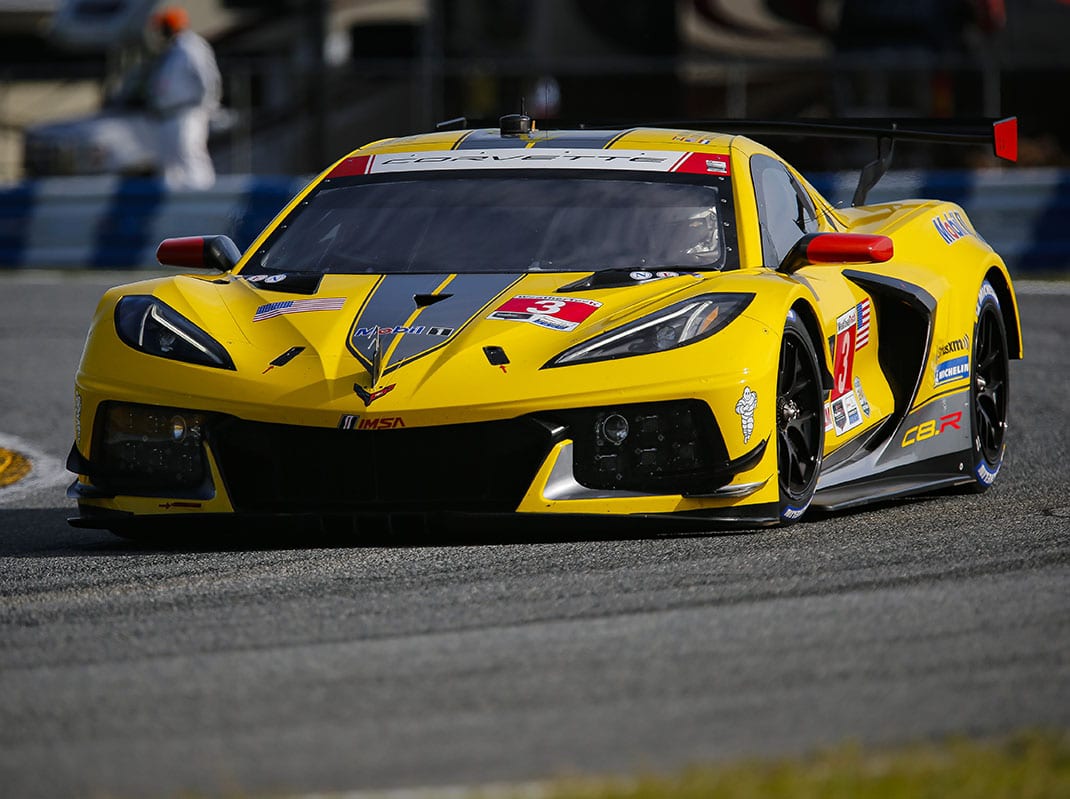The much-anticipated Corvette C8-R rumbled to life in late January during the Rolex 24 At Daytona.
Rumors of a mid-engine Corvette have been swirling for years and Velocity Yellow has finally taken a new shape with a different exhaust note. It also has some big boots to fill.
The C8-R’s predecessors have racked up 107 victories, a Triple Crown (Rolex 24 At Daytona, 12 Hours of Sebring and the 24 Hours of Le Mans wins in the same year), 13 team titles and 12 manufacturer and driver championships.
Corvette Racing boss Doug Fehan put it this way during an interview with SPEED SPORT’s Ralph Sheheen: “When I hear those numbers it’s crazy. That time has flown by and to be part of that has truly been a blessing. We tend to look at this thing as cars and performance, noise and excitement, but at the end of the day it all comes down to the people doesn’t it?
“Our program has had the dedication and passion, and have fallen in love with Corvette and really enjoyed taking it forward.”
The C8-R isn’t just another evolutionary chapter, it’s a whole new book and Fehan and his team are writing it.
“We’ve got to write the book on this car … and Daytona was the first chapter in that book,” Fehan said.
Gary Pratt’s company, Pratt & Miller, has built all Corvette race cars since the C5 first hit the track.
Like Fehan, Pratt says everything is new and they don’t have “a book” to rely on.
Looking back, Pratt noted, “The other cars, the C5, C6, GT1, GT2 and C7 evolved from each other. This one (C8-R) is a totally brand-new car. Only two parts were carried over. I think it was the air jacks and the clutch. It’s all new, from the door latches to the mirrors, the suspension, the engine is in a different location, so it’s all different.”

That said, the new race car has a strong pedigree.
“When the C5 was being designed by Dave Hill, we knew it was going to be an extraordinary car,” Pratt recalled. “We knew it was going to be completely different in its method of construction. It was going to be revolutionary from a Corvette perspective. It set the standard for all future race cars.”
More importantly, the C5-R was a giant leap for General Motors.
“Herb Fishel, my boss, thought this was a good time for us to get serious about racing a Corvette from a factory perspective,” Fehan recalled. “There had never been a full factory program. It had always been out the back door, an under the radar sort of thing.
“I was excited about putting the team together, but by the same token I told him if we were going to take on the responsibility for a full factory race program, we have to be quite certain what we’ve got for product and where were we going to compete with it,” Fehan added. “So as part of the program direction, we were going to take two years to design, build and test a race car before we ever debuted it.”
GM and Corvette Racing have never looked back.
It has been said past is a prologue and there have been standout moments for Fehan. He claims the overall victory at Daytona and the first win at Le Mans are at the top of the list.
“People don’t understand how emotional it is in this sport. These are hardened guys running this thing — ‘he men,’ risk takers. You sit around at a 24-hour race and you’ve been up for 32 hours by the time it’s over and you’ve left it all out on the field,” Fehan continued. “It’s amazing how you can break down like a child. It’s emotional for me to talk about it. That first win at Le Mans was incredible, just incredible. In the pit box there was not a dry eye.
“Grown men in tears, openly sobbing in tears,” he added. “You follow that up 30 minutes later on that podium looking down at that sea of people. They’re playing the national anthem, ‘It’s ah, wow.’ Those are things you never, ever, ever forget.”
There have been lighter moments, too.
“The French didn’t have a positive perception of Corvette … being driven by pimps, prostitutes and drug dealers. That’s who owned Corvettes over there,” Fehan said. “That was a problem. We had a lot of candid and forthright meetings aside from the pure competition aspect of it, we had a huge mountain to climb.
“I told Gary Claudio (GM marketing manager at the time) to have at it. It happened in scrutineering, which takes place downtown, not at the race track,” Fehan continued. “All of the people at Le Mans come out. It’s a huge event. It’s totally amazing, not like anything you have ever seen in motorsports. We moved through this maze of technical stations … when you get all done, the cars are parked in a special place. The teams are positioned behind the cars for the official photo that is taken for the program, very traditional, very ceremonial. That’s the French culture.
“Gary had gotten each of us a beret and a fake mustache. We were wearing cowboy hats because the French love cowboy hats, but we took them off and put on the berets and mustaches,” Fehan added. “Two things occurred. The French crowd broke out in applause. They were already loving us for the cowboy hats. The scaffolding for the photographers was elevated. It was about 20 feet in the air and was shaking so hard because they were laughing so hard that they had to wait until they settled down to take the pictures. That appeared in the regional newspaper above the fold the next day.”
Click below to keep reading.
